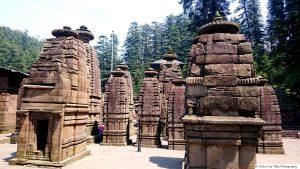Jageshwar Temples, Almora, Uttarkhand
| Date built: | – |
|---|---|
| Deity: | – |
| Architectural style: | – |
| Major festivals | – |
| Locale: | – |
| District:: | Almora |
| Address: | – |
| Phone | – |
Jageshwar Temples, also referred to as Jageswar Temples or Jageshwar valley temples, are a group of over 100 Hindu temples dated between 7th and 12th century near Almora, in the Himalayan Indian state of Uttarakhand.The valley has a number of temple clusters such as the Dandeshwar and Jageshwar sites. Some locations have attracted construction of new temples through the 20th-century. Together these clusters over the valley consist of over 200 structural temples built from cut stone. Many are small, while a few are substantial. They predominantly illustrate North Indian Nagara style of architecture with a few exceptions that show South and Central Indian style designs, many are dedicated to god Shiva, while others in immediate vicinity are dedicated to god Vishnu, Shaktigoddesses and Surya traditions of Hinduism.
Jageshwar is a Hindu pilgrimage town and one of the Dhams (pilgrimage region) in the Shaivism tradition. The site is protected under Indian laws, and managed by the Archaeological Survey of India (ASI). It includes Dandeshwar Temple, Chandi-ka-Temple, Jageshwar Temple, Kuber Temple, Mritunjaya Temple, Nanda Devi or Nau Durga, Nava-grah temple, a Pyramidal shrine, and Surya Temple. The site celebrates the Jageshwar Monsoon Festival during the Hindu calendar month of Shravan (overlaps with July-August) and the annual Maha Shivratri Mela (Shivratri festival), which takes place in early spring.
There are other Hindu temples in the Himalayan region that are called Jageshwar Temple such as one in Dalash, Himachal Pradesh
Architecture
Jageshwar is located 36 kilometres (22 mi) northeast of Almora, in the Kumaun region. The temples site is on the south of the road, across which is an eponymous village at an altitude of 1,870 m, in the Jataganga river valley near a Deodar forest (Cedrus deodara). The temple clusters begin starting from satellite road branching off east from the Artola village on the Almora–Pithoragarh highway, at the confluence (sangam) of two streams Nandini and Surabhi after they flow down the hills in the narrow valley.The site is about 3.5 kilometres (2.2 mi) long along the Jataganga rivulet, is a narrow forested valley of oaks, deodara, rhododendrons and pines. Around the valley is human habitation which provide services to the pilgrims and travelers visiting these temples or passing through to other sacred sites in the Uttarkhand region. The resident villages are Mokshadham, Dandeshwar, Jageswar and Koteshwar.
Jageshwar is about 100 kilometres (62 mi) southeast of the historic Baijnath Temple and about 100 kilometres (62 mi) northeast from the resort town of Nainital. It is mentioned in Hindu texts dated prior to the 10th-century as a tirtha (pilgrimage) site.
The nearest rail head is Kathgodam 125 km. Jageshwar has direct road links with Almora (35 km), Haldwani (131 km.), Pithoragarh (88 km) and Kathgodam. State transport, and private jeeps and taxis ply from these place for Jageshwar regularly.
Legend / Local stories
The origins of the Jageshwar temples site are unclear. Its remote location has limited its studies and scholarly attention. The site shows evidence of different architectural styles and building periods for both temples and stone steles, which range from the 7th to the 12th century, and then in the modern times.Estimates for the same temple or stele varies widely, sometimes 1,400 years. According to the ASI, some belong to the post-Gupta or the second half of 1st millennium while others belong to the 2nd millennium. Some colonial era guesses attribute them to the Katyuri or Chand hill dynasties but there is no textual or epigraphical evidence to support or refute these proposals. Another prevailing theory is that Adi Shankara built some of these temples, but once again there is no textual or epigraphical evidence to support this claim. Instead, the architectural features and style of some of these Hindu temples is from early 7th century, which is about 50 to 100 years before Adi Shankara lived (c. 788-820 CE).
The lack of systematic studies of Indian temples and ruins in many parts of the remote Himalayan regions limits what can be said about the chronological sequence of monuments in the Jageshwar valley. According to Chanchani, it is likely that the valley had reached a prominent position in Indian architecture by the 10th century, with the earliest monuments from the 7th-century.
The valley has two major clusters of Hindu temples, and a number of roadside shrines. Of these some 151 temples have been numbered by ASI as protected pre-12th century monuments. The two largest groups are locally called as the Dandeshwar group temples (Dandeshwar samuh mandir, 15 temples) and the Jageshwar group temples (Jageshwar samuh mandir, 120 temples). Of these, temple number 37, 76 and 146 are the largest, all dated to the late centuries of the 1st millennium. In historic text, Jageshwar is also referred to as Yageshvara.
Jageshwar was once the center of Lakulish Shaivism, likely by monks and migrants who left the plains of the Indian subcontinent from places such as Gujarat and settled in the high mountains. The resemblance between Kumaoni language and Gujarati language probably hints at the fact that followers of Lakulish settled at Jageshwar. The temples site over time was positioned as and grew as a sacred geography in the form of northern (uttara) Kashi (Varanasi).
Photo Gallery
How to Reach:
Contact Details
Official Address



















